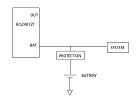Other Parts Discussed in Thread: BQ24040
Hi,
I started a design with the BQ24072T a while back and now the specs have changed so a higher discharge currents need to be used. I thought that a possible solution would be to connect the electronics system directly to VBAT, adding some protection for the battery and not using Vout as my system input.
I have done some tests and the discharging works fine, however, I have problems charging the battery when is fully discharged (protection kicks below 2.8V).
I have attached an image for a better understanding..
So the questions are, can this work? if so, why does not charge when fully discharched and a load connected? (if disconnect the load it starts charging)
- When not charging:
- OUT = 3.4V
- BAT = 0.98V
- CE = 0V
- EN1 = 0
- EN2 = 3.3V
- 120 ohms resistor in paralel with battery
- 10k load on OUT
- OUT = 3.4V
- BAT = 3.38V
- CE = 0V
- EN1 = 0
- EN2 = 3.3V
- open circuit
- 10k load on OUT
Thanks in advance!


